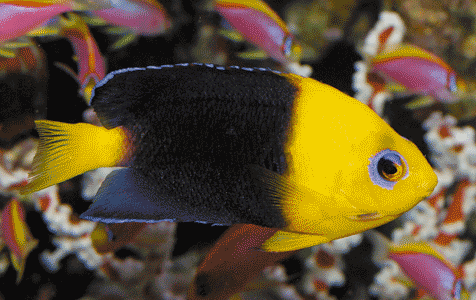Cocos Pygmy Angelfish
From Microcosm Aquarium Explorer
Rarities
Centropyge joculator
Blue and yellow/orange appear to be extremely popular colors in the genus Centropyge. Many species, for example C. acanthops, its Caribbean relatives C. argi and C. aurantonotus, and the Pacific C. bicolor, exhibit this striking color combination. The list goes on, and includes Centropyge joculator, which—at least to the unpracticed eye—looks confusingly similar to the above-mentioned C. bicolor. But while C. bicolor is a popular aquarium fish, C. joculator is regarded as a true rarity, a sort of “posh” version of the blue-and-yellow Bicolor Angelfish—perhaps a teeny bit more attractive than the other species, but definitely much more expensive.
C. joculator inhabits the coral reefs of the eastern Indian Ocean and occurs all around Christmas Island and the Cocos Islands—a habitat that has certainly contributed to the exclusive image of this fish. It inhabits not only areas rich in corals but also expanses of boulders at depths of up to 230 feet (70 m), and forms genus-typical harems of four or five individuals. The species is well suited to aquarium maintenance and not appreciably different from other robust members of the genus. With a total length of 4 inches (10 cm), this dwarf angelfish is one of the medium-sized species and, as a rule, rather outgoing. Feeding is also without problems in the aquarium. Various frozen foods, as well as dry and algae-based foods, are greedily taken (R. Baur, pers. comm.).
As with all Centropyge species, it is advisable to keep these fishes in pairs; this can easily be achieved by housing two individuals of different sizes together. It is also particularly nice to keep them in the natural manner, as a harem, in the aquarium—to do this, you will need three or four juveniles or females and one adult male. But because life in the harem, even in the natural habitat, is not without moments of tension—in the final analysis, the male must permanently assert his dominant position—this form of maintenance should be attempted only in very large aquariums (400 gal./1,500 L upwards). In addition, the acquisition of enough specimens to make up a harem will have quite an impact on the aquarist’s wallet: the cost of five Cocos Pygmy Angelfish could pay for a week-long diving vacation in the Indian Ocean, where one can see these wonderful dwarf angelfishes in the wild. —Inken Krause
Excerpt from CORAL Magazine, Volume 6 #4, July/August, 2009. To read more from this issue Click Here.









